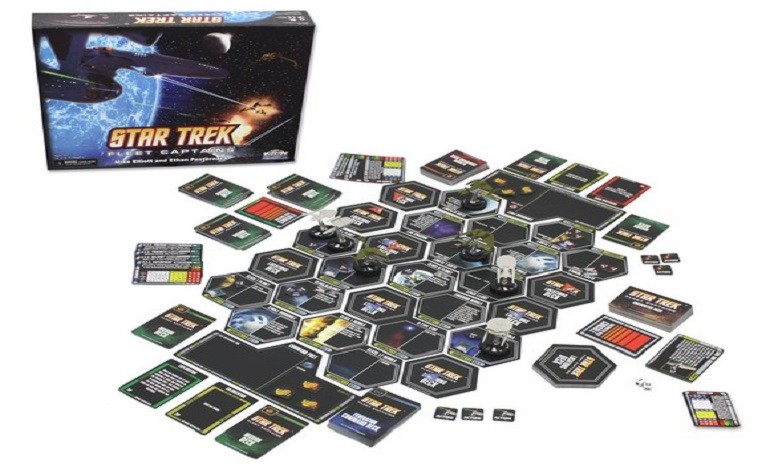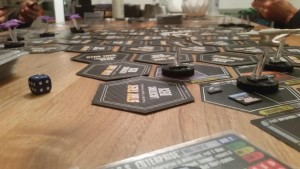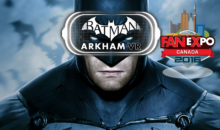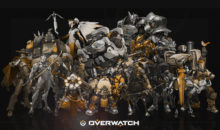Evoking Spock in Star Trek: Fleet Captains
NB: The board gaming group I belong to gets together every Friday night. We usually play a game centred on a particular theme. This night, we were all feeling significantly moved by Leonard Nimoy’s passing.
It was a pretty crappy day: Leonard Nimoy sadly left this planet to explore other frontiers and my band of boardgamers were left with the dilemma on how to best honour this sci-fi television legend.
Star Trek is of course, a very popular subject for board games, but when it comes to capturing the spirit and true essence into another medium of this popular television franchise, then you really have to look no further than Wiz Kids’ Star Trek: Fleet Captains; so that was the game of choice to invoke the spirit of Spock of Vulcan.
Chances are you’ve already seen this game. It was released in 2011 and there have been a couple of supplements released that represent the different races and aspects of this game. So it’s nothing new, but it is a pretty memorable game.
Star Trek is foremost about encounter and discovery, as interpreted by the various races within Gene Roddenberry’s universe. When the initial game set was published, it featured only two of the major races: the United Federation of Planets and the Klingon Empire. The objective of the game is to complete a series of missions that are worth victory points. The first player to reach a pre-determined amount of points is declared the winner.
Each player is allotted a certain amount of build points to construct a fleet of starships that have different capabilities: Engines, Sensors, Weapons and Shields are all reflected on each ship’s information card. The races have command cards that grant their ships special abilities and bonuses in given situations in addition to various crew members who can also add their unique talents and characters to the game play.
However, the primary mechanic in the game is the discovery angle. The board is comprised of various face-down hexagonal tiles that contain planets, stars, spatial anomalies and varying probabilities of mission encounters that starships can uncover. If a mission encounter is experienced, then that’s where victory points can be scored and the command cards come into play to improve chances to score points or create favourable conditions for more points in the future.
The player chits were pulled with the Dominon, the Romulans and the Federation represented in a three-way game.
Now, you might think this corny, but with the Federation pulled by yours truly, the spirit of Nimoy needed to be evoked. So with a ready selection of Nimoy’s musical offerings playing in the background (have you ever tried to explore an unstable wormhole to “The Ballad of Bilbo Baggins”?) and am ample selection of beer on hand, we set out to explore or conquer the galaxy.
The Dominion strategy is fairly simple: establish bases and dominate combat encounters. Their command cards are set up to reflect that by allowing them to accelerate construction times of colonies, outposts and starbases. Each requires a certain amount of time and influence tokens to be dropped. They also receive bonuses in combat like suicide runs and unique weapons like the Breen energy dissipator.
The Dominion also gets a major advantage in that they have three different races that make up their fleet – the Jem H’adar, the Cardassians and the Breen. Each offer unique ships, abilities and crew members, so their diversity makes up for the rigidity of their tactical options.
The Romulans have a unique ability in that they can plant covert operatives on board enemy ships as saboteurs to incapacitate them in key moments. The basic Romulan strategy revolves around deception and intelligence gathering so their command cards give them bonuses to sensor use or as they use their cloaking devices in combat.
As you would expect, the Federation basic strategy is based on science missions and diplomatic initiatives. While it is tempting to take the Enterprise-E as the flagship to your fleet, the problem with that decision is that is difficult to create a fleet of ships that are combat equivalent to the other two races. So, invoking Vulcan logic and Nimoy-appropriate ships, I chose the Enterprise-A, the Reliant and the Enterprise-D as my fleet.
My first action was to see what sort of mission cards were at my disposal. All were scanning missions – to explore a series of planets, stars and other spatial anomalies. Each was worth a victory point and was extremely attainable.
Drawing from my Fleet decks, I was fortunate enough to gain a great amount of crew members, like Picard, McCoy, Scotty and the Doctor. I assigned them to various ships, but it would have been really useful to draw a science specialist.
I also knew that the others’ strategies would be to expand as far as they could, in order to initiate combat and to engage each other. Sure enough, given the Dominion’s expansionist nature, the Jem H’Adar scarabs and Cardassian battlecruisers were ranging deep into space, targeting each other with their respective weapons systems. Given the formation of the tiles was a three-pronged triskelion, it would be to my advantage to just stay as far away from the two players as I could! So I split my ships, stayed close to my base and dropped influence tokens as I explored to create a dense but small pocket of Federation influence.
Very logical strategy, right? I think Spock would have approved.
As I predicted, battle ensued and I quietly flew from tile to tile, completing as many exploration and science missions as I could. I built starbases, escaped deadly time-distortion loops and made it a point to place my ships on the other side of planets or tiles with navigational obstacles. Sure, it felt cowardly, but the operating principle behind my game-play was: what would Spock do? I divested myself of the impulsive need to best Romulan warbirds in combat or to stand up to the bullying nature of the Dominion and kept my focus on the objectives on scoring victory points.
I enhanced my shields to survive deadly natural encounters; I diverted power to the warp engines to cross as many tiles within my small corner of Federation Space as I could in order to pick up as many encounters. I also made it a point to cycle through my mission cards as much as I could in order to obtain more easily obtainable missions. Mundane as it sounds, that is a key tactic to adopt in this game, and one that is extremely easy and efficient to employ.
When it came to the final turn, I had the chance to simultaneously score multiple points in one turn. As you can only claim one victory (regardless of the amount of the points) per turn, this was a decisive action that would put me over the other players’ totals. I turned over a fleet card … and Commander Spock looked back at me.
It was the Vulcan equivalent of kismet.
With a calm demeanour masking my excitement, I assigned the crew card to none other than … the Reliant. Why, would you ask? Wouldn’t it have been more thematic to assign him to the Enterprise-A?
Yes, it would, but that is both the appealing and crippling mindset present. Star Trek: Fleet Captains is a game that allows you to experience the sensation of being in an actual episode. You have crew members to command, alien ships to engage in combat and discovering new and exciting aspects of the galaxy. But if you play this game from a strictly thematic viewpoint, you are doomed to lose. Don’t assign Kirk to the USS Enterprise he is all too familiar with; place him on the Enterprise-E in order to maximize his special combat bonuses.
I placed Spock on the Reliant because its special ability is to always have an incredibly high sensor rating. It was the ship that would allow me to score those multiple points in a sensors test, and Spock added extra bonuses to the sensor dice rolls. Even though I was assigning him to the ship that ultimately ended his life in Wrath of Khan, I was certain to succeed. Thematic – no, but an extremely smart move that ultimately won me the game.
It’s a game that allows its players to experience a great amount of theme – if they so choose. After all, if years of watching Star Trek have taught nerds anything, it’s that the spirit of exploring, or in this case the spirit of play, means everything. Winning is nice, but it’s the joy of the game and how you play it that truly matter.
Spock would have approved: it was a logical and inexorable victory … which is how it should be done.









